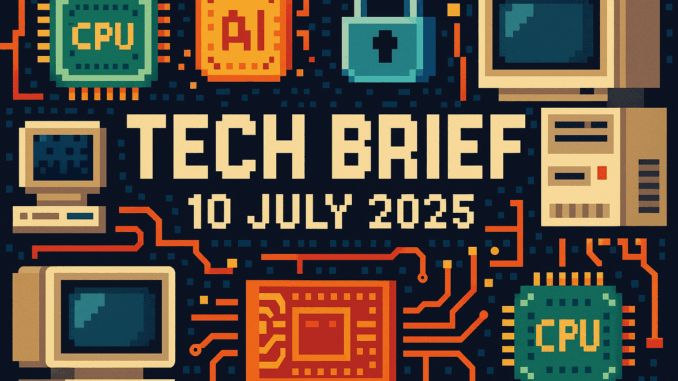
Picture this: you’re hunched over a beige tower in 1995, meticulously organising Netscape Navigator bookmarks into folders. Hours spent crafting the perfect toolbar setup. That obsessive browser customisation feels quaint now, but Tech Brief – 10 July 2025 proves we’re still chasing the same dream of perfect web efficiency.
Today’s stories span Perplexity’s ambitious new browser to AMD’s latest security headaches. The more silicon evolves, the more familiar these patterns become.
Perplexity Launches AI Browser Comet to Challenge Google
Perplexity has dropped Comet, an AI-integrated browser that embeds search tools directly into your browsing experience. Built on Chromium, it promises natural language queries and contextual content summarisation. No more tab-juggling dance between search and browse.
Anyone who lived through Netscape Navigator’s glory days will recognise the ambition here. Comet targets the same efficiency-obsessed users who once spent weekends perfecting their browser setups. The difference? Instead of manually bookmarking research, Comet’s AI proactively assists with information retrieval and real-time collaboration.
CEO Aravind Srinivas positions this as browser evolution, not revolution. The AI models analyse content in real-time whilst adaptive privacy controls keep your data secure. Mobile versions arrive late 2025, suggesting Perplexity learned from early browser makers who ignored the mobile shift.
Perplexity’s approach aligns with the EU Digital Markets Act’s requirements regarding interoperability and data portability, though no direct regulatory confirmation has been provided. For users tired of search-then-browse workflows, Comet could streamline web interaction significantly.
AMD Discloses New Spectre-Style CPU Vulnerabilities
AMD has revealed Transient Speculative Execution (TSE) vulnerabilities affecting Ryzen and Epyc CPUs. These side-channel attacks exploit speculative execution to leak sensitive data across applications. The flaws echo the familiar Spectre vulnerabilities that haunted processors in 2018.
The disclosure hits familiar notes for anyone who debugged IRQ conflicts in the 90s. Back then, hardware fixes meant physical tinkering and careful driver management. Today’s microcode updates and OS patches offer cleaner solutions. Performance penalties remain brutal though.
TSE impacts Zen 3 and Zen 4 architectures specifically. Independent security researchers discovered the flaws, continuing the pattern of academic scrutiny that exposed the original Spectre vulnerabilities. AMD has not yet assigned CVE identifiers, though they indicate patches will release in Q3 2025.
Intel and ARM are investigating analogous flaws in their designs. The cyclical nature of hardware vulnerabilities proves that silicon complexity always outpaces security review. For system administrators managing mixed CPU environments, this represents another patching headache requiring careful testing and rollback planning.
UK Positions Cybersecurity as Core Industrial Strategy Pillar
The UK government has elevated cybersecurity to a core pillar of its Industrial Strategy. The plan targets top-three global tech hub status by 2035. Funding includes critical infrastructure hardening and 10,000 new cyber-apprenticeships.
This strategy validates what NT4.0 administrators knew decades ago. Robust infrastructure beats flashy features every time. The focus on legacy systems in healthcare and utilities addresses vulnerabilities that accumulated whilst everyone chased cloud migration. Air-gapped systems and quantum-resistant encryption get specific attention.
TechUK advocates for public-private threat intelligence sharing. Government and industry must collaborate against sophisticated attacks. The apprenticeship programme acknowledges Britain’s skills shortage whilst building domestic expertise rather than relying on imported talent.
Implementation begins Q4 2025 with benchmarks set for 2030. The proposed UK Cyber Security and Resilience Bill provides regulatory backing. For organisations running mixed legacy and modern infrastructure, this represents long-overdue recognition that security requires sustained investment, not quick fixes.
Corporate Deepfake Defence Lessons from Marco Rubio Attack
AI clones impersonating U.S. Secretary of State Marco Rubio have generated six critical corporate defence lessons. The analysis covers multi-factor authentication for executive communications, staff training for spotting vocal artifacts, and blockchain-based identity verification.
For anyone who spent hours deleting Nigerian prince scams from their inbox, this represents sophisticated evolution. Deepfakes exploit trust in familiar voices and faces rather than obvious greed. Tools like Intel’s FakeCatcher and Adobe’s Content Credentials offer detection capabilities, but human training remains essential.
The incident exposed how deepfakes target public figures to manipulate policy or markets. Pre-drafted crisis response plans and partnerships with law enforcement for forensic tracing become crucial. Third-party AI tool audits help prevent inadvertent creation of compromising content.
The EU AI Act mandates watermarking for deepfakes, though implementation specifics remain under development. For executives who remember when email spoofing was cutting-edge social engineering, deepfakes represent a quantum leap in deception capability requiring proportional defensive measures.
From the Wayback Machine
On This Day: 1962 – Telstar 1 launched from Cape Canaveral, becoming the first active communications satellite. Weighing 77kg with 3,600 solar cells, it enabled the first live transatlantic television broadcast on July 23rd. The 88cm sphere used a travelling wave tube amplifier to boost signals 100-fold, despite only 14 watts output power. Bell Labs engineered the satellite whilst AT&T funded the project, eager to expand global telecom offerings. Ground stations in Maine and Europe coordinated the brief daily transmission windows created by Telstar’s elliptical orbit. The achievement catalysed satellite communications, directly inspiring today’s global internet infrastructure and LEO constellations like Starlink.
What This Means
Tech Brief – 10 July 2025 reveals how past innovations shape present challenges. Browser evolution continues with AI integration. CPU vulnerabilities follow predictable cycles requiring constant vigilance. National cyber strategies finally prioritise infrastructure over headlines. Deepfake threats demand the same systematic approach that defeated earlier social engineering. Each story connects to foundational technologies that transformed global communications, from Telstar’s first satellite broadcasts to today’s ubiquitous connectivity.
The more things change, the more they stay brilliantly, frustratingly familiar.
There’s more news where that came from – check out yesterday’s Tech Brief here.

Leave a Reply